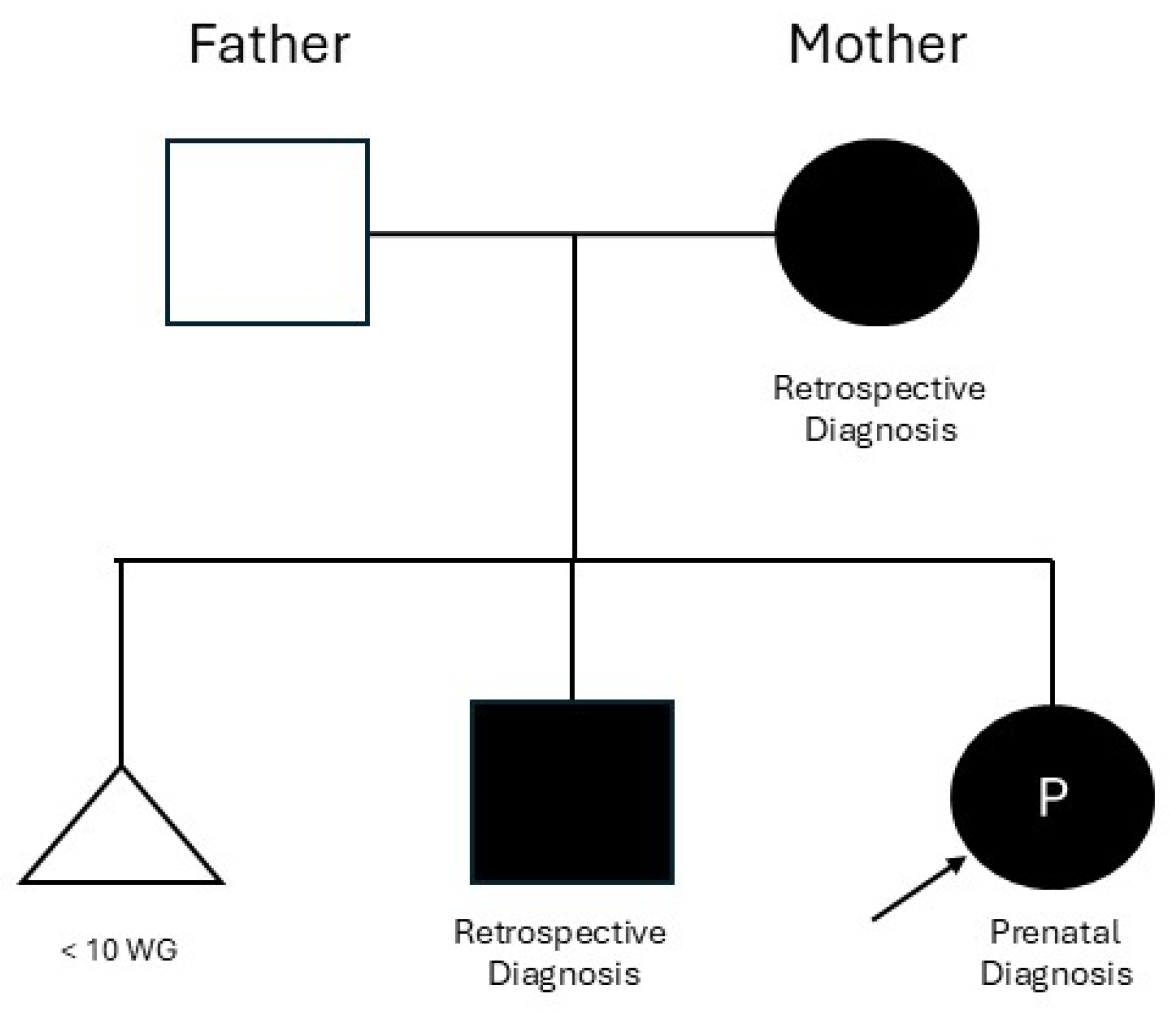More than a Diagnosis: How Prenatal Identification of Cantú Syndrome Transformed a Family’s Medical Narrative
Abstract
1. Introduction
2. Materials and Methods
2.1. Clinical Data Collection
2.2. Genetic Evaluation and Comprehensive Fetal Medicine Approach
2.3. Clinical Interview and Qualitative Analysis
3. Results
3.1. Clinical and Obstetric History
3.2. Ultrasound Findings in the Current Pregnancy
3.3. Genetic Diagnosis and Family Analysis
3.4. Emotional Impact of the Diagnosis
3.5. Obstetric and Neonatal Outcome
4. Discussion
4.1. Implications for Future Research and Potential Clinical Applications
- Targeted prenatal screening protocols: Incorporating characteristic ultrasound features (e.g., polyhydramnios, edema, frontal hypertrichosis) into diagnostic workflows can help identify candidates for advanced genetic testing.
- Implementation of precision fetal medicine models: Trio exome sequencing allows for a personalized approach, enabling the anticipation of specific perinatal complications and facilitating individualized obstetric and neonatal decision-making, including delivery planning and resource allocation.
- Genetic counseling and reproductive planning: The prenatal identification of an autosomal dominant condition like Cantú syndrome enables the detection of asymptomatic carriers within the family, tailored reproductive counseling, and access to preimplantation genetic diagnosis (PGD) in future pregnancies.
- Reutilization of archived biological samples: The retrospective analysis of preserved fetal samples from previous undiagnosed pregnancies can be incorporated as a standard practice in fetal medicine units, allowing the reinterpretation of unresolved cases in light of new genetic findings and improving familial counseling.
- Development of psycho-emotional support tools: Integrating the evaluation of emotional impact into prenatal care can guide the creation of targeted psychological interventions for families confronting rare diseases, improving maternal–fetal well-being and fostering family resilience.
4.2. Emotional Insight and Qualitative Impact
5. Conclusions
Author Contributions
Funding
Institutional Review Board Statement
Informed Consent Statement
Data Availability Statement
Acknowledgments
Conflicts of Interest
Abbreviations
| CS | Cantú Syndrome |
| ABCC9 | ATP-Binding Cassette Sub-Family C Member 9 |
| KCNJ8 | Potassium Inwardly Rectifying Channel Subfamily J Member 8 |
| QF-PCR | Quantitative Fluorescent Polymerase Chain Reaction |
| WES | Whole Exome Sequencing |
| ICSR | International Cantú Syndrome Registry |
| CEI | Comité de Ética de la Investigación |
| RCIU | Restricción del Crecimiento Intrauterino |
References
- Grange, D.K.; Roessler, H.I.; McClenaghan, C.; Duran, K.; Shields, K.; Remedi, M.S.; Knoers, N.V.A.M.; Lee, J.-M.; Kirk, E.P.; Scurr, I.; et al. Cantú syndrome: Findings from 74 patients in the International Cantú Syndrome Registry. Am. J. Med. Genet. C Semin. Med. Genet. 2019, 181, 658–681. [Google Scholar] [CrossRef] [PubMed]
- Vasta, A.; D’Ambrosio, V.; Di Mascio, D.; Bottillo, I.; Formicola, D.; Bacigalupo, F.; Grammatico, P.; Pizzuti, A.; Rizzo, G.; Giancotti, A. EP18.19: Prenatal diagnosis of Cantú syndrome during the second trimester due to a novel ABCC9 pathogenic variant: A case report. Ultrasound Obs. Gynecol. 2024, 64 (Suppl. S1), 287. [Google Scholar] [CrossRef]
- Roessler, H.I.; Volker-Touw, C.M.L.; Terhal, P.A.; van Haaften, G.; van Haelst, M.M. Cantú syndrome, the changing phenotype: A report of the two oldest Dutch patients. Clin. Dysmorphol. 2018, 27, 78–83. [Google Scholar] [CrossRef] [PubMed]
- Mellis, R.; Oprych, K.; Scotchman, E.; Hill, M.; Chitty, L.S. Diagnostic yield of exome sequencing for prenatal diagnosis of fetal structural anomalies: A systematic review and meta-analysis. Prenat Diagn. 2022, 42, 662–685. [Google Scholar] [CrossRef] [PubMed]
- Talati, A.N.; Gilmore, K.L.; Hardisty, E.E.; Lyerly, A.D.; Rini, C.; Vora, N.L. Impact of prenatal exome sequencing for fetal genetic diagnosis on maternal psychological outcomes and decisional conflict in a prospective cohort. Genet. Med. Off. J. Am. Coll. Med. Genet. 2021, 23, 713–719. [Google Scholar] [CrossRef] [PubMed]
- Kolemen, A.B.; Akyuz, E.; Toprak, A.; Deveci, E.; Yesil, G. Evaluation of the parents’ anxiety levels before and after the diagnosis of their child with a rare genetic disease: The necessity of psychological support. Orphanet J. Rare Dis. 2021, 16, 402. [Google Scholar] [CrossRef] [PubMed]
- van Bon, B.W.M.; Gilissen, C.; Grange, D.K.; Hennekam, R.C.M.; Kayserili, H.; Engels, H.; Reutter, H.; Ostergaard, J.R.; Morava, E.; Tsiakas, K.; et al. Cantú syndrome is caused by mutations in ABCC9. Am. J. Hum. Genet. 2012, 90, 1094–1101. [Google Scholar] [CrossRef] [PubMed]
- Harakalova, M.; van Harssel, J.J.T.; Terhal, P.A.; van Lieshout, S.; Duran, K.; Renkens, I.; Amor, D.J.; Wilson, L.C.; Kirk, E.P.; Turner, C.L.S.; et al. Dominant missense mutations in ABCC9 cause Cantú syndrome. Nat. Genet. 2012, 44, 793–796. [Google Scholar] [CrossRef] [PubMed]


Disclaimer/Publisher’s Note: The statements, opinions and data contained in all publications are solely those of the individual author(s) and contributor(s) and not of MDPI and/or the editor(s). MDPI and/or the editor(s) disclaim responsibility for any injury to people or property resulting from any ideas, methods, instructions or products referred to in the content. |
© 2025 by the authors. Licensee MDPI, Basel, Switzerland. This article is an open access article distributed under the terms and conditions of the Creative Commons Attribution (CC BY) license (https://creativecommons.org/licenses/by/4.0/).
Share and Cite
Narbona-Arias, I.; Blasco-Alonso, M.; Monís-Rodriguez, S.; Muñoz, C.G.; González-Mesa, E.; Lubián-López, D.M.; Jiménez-López, J. More than a Diagnosis: How Prenatal Identification of Cantú Syndrome Transformed a Family’s Medical Narrative. J. Clin. Med. 2025, 14, 6017. https://doi.org/10.3390/jcm14176017
Narbona-Arias I, Blasco-Alonso M, Monís-Rodriguez S, Muñoz CG, González-Mesa E, Lubián-López DM, Jiménez-López J. More than a Diagnosis: How Prenatal Identification of Cantú Syndrome Transformed a Family’s Medical Narrative. Journal of Clinical Medicine. 2025; 14(17):6017. https://doi.org/10.3390/jcm14176017
Chicago/Turabian StyleNarbona-Arias, Isidoro, Marta Blasco-Alonso, Susana Monís-Rodriguez, Cristina Gómez Muñoz, Ernesto González-Mesa, Daniel María Lubián-López, and Jesús Jiménez-López. 2025. "More than a Diagnosis: How Prenatal Identification of Cantú Syndrome Transformed a Family’s Medical Narrative" Journal of Clinical Medicine 14, no. 17: 6017. https://doi.org/10.3390/jcm14176017
APA StyleNarbona-Arias, I., Blasco-Alonso, M., Monís-Rodriguez, S., Muñoz, C. G., González-Mesa, E., Lubián-López, D. M., & Jiménez-López, J. (2025). More than a Diagnosis: How Prenatal Identification of Cantú Syndrome Transformed a Family’s Medical Narrative. Journal of Clinical Medicine, 14(17), 6017. https://doi.org/10.3390/jcm14176017









